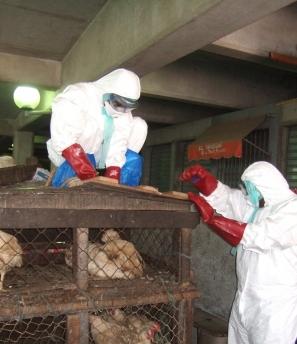In the wake of widespread poultry outbreaks caused by three different highly pathogenic avian flu strains, Taiwanese health officials are monitoring more than a thousand farm workers and public health workers, though so far there have been no signs of transmission to humans.
Animal health officials in Taiwan are battling multiple outbreaks of H5N8 and H5N2 avian influenza, along with H5N3, which the region's veterinary experts have said is a novel strain. Yesterday regions reported several new outbreaks involving all three strains.
A host of other countries have also reported recent H5N8 and H5N2 outbreaks in poultry.
Tests turn up no bird-to-human transmission
The Taiwan Centers for Disease Control (Taiwan CDC) said in a statement yesterday that as of Jan 20, it was monitoring 1,377 people for flulike symptoms. It urged poultry workers at farms hit by avian flu to notify the local health department if they start having respiratory symptoms and to tell health providers about their exposure and job history.
As a precaution, Taiwan CDC said it would monitor everyone who had been exposed to the infected poultry farms for 10 days and further evaluate and test those who come down with flulike symptoms.
So far, 32 people have had symptoms. Respiratory samples were collected from 22 of the patients, with 1 sample testing positive for seasonal influenza and 21 showing negative results. The remaining 10 people are still being monitored, and 3 are no longer under surveillance, the agency said.
As in Taiwan, no human infections with H5N8 or H5N2 have been reported in other countries grappling with similar outbreaks in poultry. The H5N2 strain has not been isolated from humans, but some studies have found possible serologic evidence of subclinical infections in workers who had frequent contact with infected poultry.
In November after H5N8 was detected in Germany, the European Centre for Disease Prevention and Control (ECDC) said the public health risk was low, because no human infections from that strain have ever been reported.
Three strains hit 61 more farms in Taiwan
Taiwan agriculture officials in separate updates to the World Organization for Animal Health (OIE) reported 21 more H5N8 outbreaks, 39 more H5N2 outbreaks, and 1 more H5N3 outbreak.
The H5N8 outbreaks began earlier this month, and the 21 most recent events started on Jan 16 and Jan 17 and affected goose farms in Yunlin County, Tainan City, and Pingtung County, all in the southwestern part of the island. Of 84,249 susceptible birds, the virus killed 8,562, and the remaining geese were culled to curb the spread of the virus.
Meanwhile, authorities detected H5N2 at 39 more farms housing mostly geese, but also some that had ducks and chickens. The outbreaks hit sites in five different counties: Yunlin, Pingtung, Chiayi, Changhua, and Kaohsiung. All are on the central and southern part of the island's western side. Of 172,324 susceptible birds, the virus killed 30,086, with the rest slated for culling.
Officials yesterday said they detected H5N3 at one more farm, one that houses geese in Pingtung County. The outbreak began Jan 16, killing 500 of 4,200 susceptible birds.
Other avian flu developments
- German animal health officials today reported another H5N8 outbreak, this time in poultry at a zoo in Mecklenburg-Vorpommern state, located in the northern part of the country. According to a report to the OIE, the outbreak began on Jan 20, with the virus killing 4 of 98 susceptible birds of several different species. The remaining chicken, ducks, and geese were culled the next day. Germany has been battling the H5N8 virus in poultry since early November.
- Palestinian agriculture authorities on Jan 20 reported a highly pathogenic H5 outbreak at a turkey farm in Jenin, according to a notification to the OIE. The event began Jan 17, killing 12,000 of 17,400 susceptible birds. The remaining turkeys were culled to stem the spread of the virus. The report didn't say which strain of H5 was detected. A few days ago Israeli officials reported an H5N1 outbreak at a turkey farm in Haifa.
- The US Department of Agriculture (USDA) on Jan 20 posted an update on recent avian influenza findings in the Pacific flyway. It noted that the findings have been limited to wild birds and backyard poultry flocks that have access to the outdoors and that none of the viruses have been detected in commercial poultry. Strains have included highly pathogenic H5N2 and H5N8, and the agency said no human cases have been detected in the United States, Canada, or internationally. Officials recently detected a novel H5N1 virus in a hunter-killed duck in Washington state. The USDA said the increased detections are part of increased avian influenza surveillance in the Pacific flyway, and because H5N8 and H5N2 are circulating in migratory birds, it expects more findings in US wild birds and backyard flocks.
See also:
Jan 21 Taiwan CDC statement
Nov 13, 2014, ECDC risk assessment
Jan 21 OIE update on H5N8 in Taiwan
Jan 21 OIE update on H5N2 in Taiwan
Jan 21 OIE update on H5N3 in Taiwan
Jan 22 OIE report on H5N8 in Germany
Jan 20 OIE report on H5 in Palestine
Jan 20 USDA statement
Jan 21 CIDRAP News story "USDA confirms high-path H5N1 in Washington state"






















